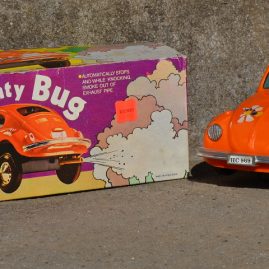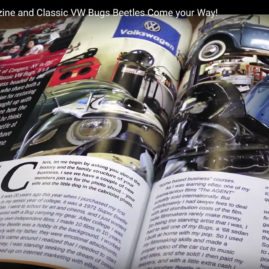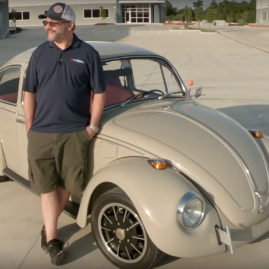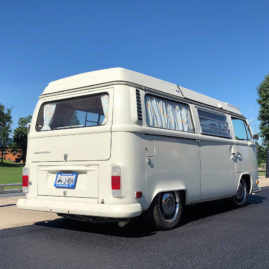by Paul Cave
When I got this car there was more rust than metal, and more holes than rust! In today’s VW patina craze I could have left it just as it was and everyone worth their salt would have flocked to it like bees to the proverbial honey pot. Then they would have fallen around laughing.
There comes a time when even the most patina-loving individual has to say “no!” and begin restoring what is essentially sections of good metal held together by sections of bad. It just wasn’t safe to drive, and the engine actually had sand in it!
The color was orange. The front fenders were so bad they were replaced with fibre-glass copies. These used items I was lucky to source were a mid blue, scratchy in places, and I liked them. Not wanting the car to be forever orange, I deliberately drove the car with these blue fenders until such time as I could make up my mind which color I’d fallen in love with. Having already owned a yellow Bug I knew it wouldn’t be yellow…
Er…
It’s VW Texas Yellow. I saw a Type 3 Fastback and thought it looked a bit yuck, but never saw a Squareback and thought, well, what do you think? The color is from the same VW palette era as the car, so it’s a perfect match. Being painted by the pros it was a very clean and shiny finish, and it stayed that way too. Never have you seen a more happy driver in his yellow car.
The sandy 1600 almost became a 1641, but I talked myself into a 1776, then a 2-liter aircooled pancake motor. It was during this time that the gearbox destroyed itself so Rancho Transaxles came to the rescue with a tough Freeway Flier to handle the torque. But being the type of person I am I love to experiment, and it wasn’t long before I got into a discussion over the VW Vanagon waterboxer versus Type 4 engine debate. I’d been a great fan of the Type 4 engine ever since I owned a VW 411 with the factory 80 bhp f.i. in Europe, and prior to that re-built and fitted a 1700 Bus engine into Split Window Bus. That particular engine was built with a few tricks that meant it could push a Bus through the air to the magic 100mph, but was a swine to labor up hills. It too demolished a transmission!
But the Vanagon engine was new territory. The European spec. 2.1 came with 112 bhp out of the factory, and when you looked at it it looked about the same size as as the Type 3 engine. In fact, it was a lot closer than I first thought. This then would be the engine of choice. Less all that complicated injection to worry over.
To cut a long story short, the 2.1 DJ engine was rebuilt over a weekend working with an old friend who knew more about these engines than I did, and we both needed a guinea pig (me) to evaluate some changes we were both keen to try. I was close to fitting a seriously spectacular, old school race cam with pedigree before I backed out to something modest that would appreciate the small faces of the followers and their hydraulic design. That said, I chose Bugpack’s 4062 which, as my well engineered friend politely informed me “was like an Engle 110 with balls!” The static compression ratio of this engine was 10.5:1. The rods were also Bugpack clearance and good for 7000 rpm. I would occasionally test them in first and second gear.
Machined adapter plates of aluminum enabled the Type 3 IDF/DRLA inlet manifolds to sandwich between the cylinder heads and carbs. A 2.1 Vanagon engine on carbs was probably a step backwards, but with the cam and four big holes now delivering the fuel what could go wrong? A CSP center-post system opened and closed the carbs, but not before I tapped and polished a couple of pushrods to accept the joined linkages.
The exhaust manifolding was kept because it’s so heavy duty it would never need replacing, however the silencer would be swapped for something much lighter and free-flowing. For ignition, a German made 009 with Lumention’s Optronic module replacing the points. The flywheel, which is essentially a Type 4 five-bolt design with a 228mm clutch attached was binned. The replacement was a lightened and balanced 210mm Type 4 flywheel (weighing way less than 10lbs) with five Porsche 914 race bolts holding it in place.
The radiator, new from a VW Passat B4 with a two speed fan switch was dropped into the spare wheel slot and sealed in situ. A chin spoiler directed air through a slot that I cut behind the bumper line, and I relocated the bumper toward the body thereby preventing the air from escaping, and forcing it into ducting that encapsulated the front side of radiator. Anyone peering downward couldn’t see there was a long hole in the bodywork. Air was expelled through the radiator’s via the spare tire outlet (removable on a Type 3) and over the front axle area. Inside the cabin space a two speed Golf heater matrix was installed which delivered hot air to the front windshield. It wan’t the quietest of fans, and fitting it was a little tricky to fit inside an early Golf center console, but it worked a treat.
Pipework from the water-pump to the radiator was via two large bore copper pipes with some brass elbow fittings at the front of the vehicle, for a while. These elbow fittings weren’t ideal and I was on the verge of replacing them with some Flexi pipe when the above photo was taken. I’d used Flexi pipe in the rear to great success. The water overflow / expansion tank was standard, and the overflow ran into a Type 2/3 screen wash water bottle, located in the engine compartment.
What was it like to drive? Marvellous. So quiet and very civilized on the road. This would have been the next step in evolution had Volkswagen not pulled the plug on the Type 3 ten years too soon! Seriously, it could have been a factory fitment, save for the spare tire now having to sit above the fuel tank or over the engine bay. 112 bhp became an honest 130+ bhp, and it idled smoothly at 800 rpm with whisper quietness. In summer traffic the two speed fans would predictably come on with the vehicle sitting still. It never once overheated, and what was nice was it warmed up in a fraction of the time an aircooled motor did, so cold winters were never a problem once I’d unfreezed the door locks!
On the road it could reach 60 mph in second gear. 90 mph could be reached in third. Those rear tires were 195/80 profile and with the 3.875:1 r/p gearing it really did like to cruise. Type 3s are heavy vehicles. This engine is heavier than the engine it replaced. A standard Type 3 Squareback weighs about 20 stone more than a Beetle of the same era. Remember that next time you go out for a drive – it’s like you and your 20 stone mate sitting beside you in the passenger seat! In top, the freeway flier option and taller than standard rear tires made it a comfortable 60 mph cruiser. At 50 mph it was off-cam. Top speed? I took it to 115mph once. My 17+ stone companion in the passenger seat just laughed. He said: “It’s like the Millennium Falcon. It’s like a light speed VW – takes a while to get to hyperspace velocity and then bits probably start falling off!”








Leave a Reply